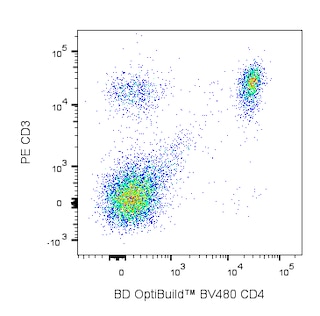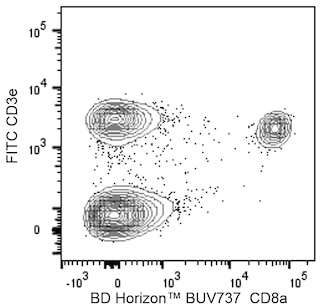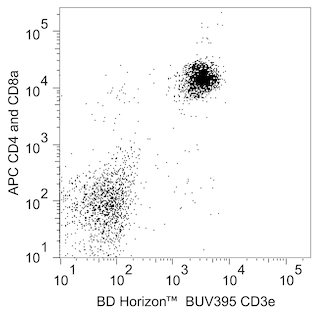-
Reagents
- Flow Cytometry Reagents
-
Western Blotting and Molecular Reagents
- Immunoassay Reagents
-
Single-Cell Multiomics Reagents
- BD® AbSeq Assay
- BD Rhapsody™ Accessory Kits
- BD® Single-Cell Multiplexing Kit
- BD Rhapsody™ Targeted mRNA Kits
- BD Rhapsody™ Whole Transcriptome Analysis (WTA) Amplification Kit
- BD Rhapsody™ TCR/BCR Profiling Assays for Human and Mouse
- BD® OMICS-Guard Sample Preservation Buffer
- BD Rhapsody™ ATAC-Seq Assays
-
Functional Assays
-
Microscopy and Imaging Reagents
-
Cell Preparation and Separation Reagents
-
Training
- Flow Cytometry Basic Training
-
Product-Based Training
- BD FACSDiscover™ S8 Cell Sorter Product Training
- Accuri C6 Plus Product-Based Training
- FACSAria Product Based Training
- FACSCanto Product-Based Training
- FACSLyric Product-Based Training
- FACSMelody Product-Based Training
- FACSymphony Product-Based Training
- HTS Product-Based Training
- LSRFortessa Product-Based Training
- Advanced Training
-
- BD® AbSeq Assay
- BD Rhapsody™ Accessory Kits
- BD® Single-Cell Multiplexing Kit
- BD Rhapsody™ Targeted mRNA Kits
- BD Rhapsody™ Whole Transcriptome Analysis (WTA) Amplification Kit
- BD Rhapsody™ TCR/BCR Profiling Assays for Human and Mouse
- BD® OMICS-Guard Sample Preservation Buffer
- BD Rhapsody™ ATAC-Seq Assays
-
- BD FACSDiscover™ S8 Cell Sorter Product Training
- Accuri C6 Plus Product-Based Training
- FACSAria Product Based Training
- FACSCanto Product-Based Training
- FACSLyric Product-Based Training
- FACSMelody Product-Based Training
- FACSymphony Product-Based Training
- HTS Product-Based Training
- LSRFortessa Product-Based Training
- United States (English)
-
Change country/language
Old Browser
This page has been recently translated and is available in French now.
Looks like you're visiting us from {countryName}.
Would you like to stay on the current country site or be switched to your country?


.png)

Multiparameter flow cytometric analysis of CD326 expression on BALB/c Mouse thymocytes and splenic T lymphocytes. Left Plot: Mouse thymocytes were preincubated with Purified Rat Anti-Mouse CD16/CD32 antibody (Mouse BD Fc Block™) [Cat. No. 553141/553142] and stained with BD OptiBuild™ BV480 Rat Anti-Mouse CD4 (Cat. No. 746475) and BD Horizon™ BUV737 Rat Anti-Mouse CD8a (Cat. No. 612759) antibodies and with either BD Horizon™ RB780 Rat IgG2a, κ Isotype Control (Cat. No. 568698; dashed line histogram) or BD Horizon™ RB780 Rat Anti-Mouse CD326 antibody (Cat. No. 568736/568737; solid line histogram) at 1.0 μg/test. The histogram showing CD326 expression (or Ig Isotype control staining) was derived from CD4- and CD8-negative gated events with the forward and side light-scatter characteristics of viable thymocytes. Middle and Right Plots: Mouse splenic leucocytes were preincubated with Mouse BD Fc Block™ and stained with BD Horizon™ BUV395 Hamster Anti-Mouse CD3e (Cat. No. 563565/565992) and BD Horizon™ BV421 Rat Anti-Mouse CD25 (Cat. No. 564370) antibodies and with either BD Horizon™ RB780 Rat IgG2a, κ Isotype Control (Middle Plot) or BD Horizon™ RB780 Rat Anti-Mouse CD326 antibody (Right Plot) at 1.0 μg/test. The bivariate pseudocolor density plot showing the correlated expression of CD326 (or Ig Isotype control staining) versus CD3e was derived from CD25+ gated events with the light-scatter characteristics of viable splenic leucocytes. A small population of CD3+CD25+CD326+ cells was detected (Right Plot), whereas the CD25- T cells did not express detectable levels of CD326 (data not shown). Flow cytometry and data analysis were performed using a BD FACSymphony™ A5 SE Cell Analyzer System and FlowJo™ Software. Data shown on this Technical Data Sheet are not lot specific.
.png)

BD Horizon™ RB780 Rat Anti-Mouse CD326
.png)
Regulatory Status Legend
Any use of products other than the permitted use without the express written authorization of Becton, Dickinson and Company is strictly prohibited.
Preparation And Storage
Recommended Assay Procedures
BD® CompBeads can be used as surrogates to assess fluorescence spillover (compensation). When fluorochrome conjugated antibodies are bound to BD® CompBeads, they have spectral properties very similar to cells. However, for some fluorochromes there can be small differences in spectral emissions compared to cells, resulting in spillover values that differ when compared to biological controls. It is strongly recommended that when using a reagent for the first time, users compare the spillover on cells and BD® CompBeads to ensure that BD® CompBeads are appropriate for your specific cellular application.
Product Notices
- When using high concentrations of antibody, background binding of this dye to erythroid fragments produced by ammonium chloride-based lysis, such as with BD Pharm Lyse™ Lysing Buffer (Cat. No. 555899), has been observed when the antibody conjugate was present during the lysis procedure. This may cause nonspecific staining of target cells, such as leukocytes, which have bound the resulting erythroid fragments. This background can be mitigated by any of the following: titrating the antibody conjugate to a lower concentration, fixing samples with formaldehyde, or removing erythrocytes before staining (eg, gradient centrifugation or pre-lysis with wash). This background has not been observed when cells were lysed with BD FACS™ Lysing Solution (Cat. No. 349202) after staining.
- Please refer to www.bdbiosciences.com/us/s/resources for technical protocols.
- Since applications vary, each investigator should titrate the reagent to obtain optimal results.
- An isotype control should be used at the same concentration as the antibody of interest.
- Please observe the following precautions: Absorption of visible light can significantly alter the energy transfer occurring in any tandem fluorochrome conjugate; therefore, we recommend that special precautions be taken (such as wrapping vials, tubes, or racks in aluminum foil) to prevent exposure of conjugated reagents, including cells stained with those reagents, to room illumination.
- Caution: Sodium azide yields highly toxic hydrazoic acid under acidic conditions. Dilute azide compounds in running water before discarding to avoid accumulation of potentially explosive deposits in plumbing.
- For fluorochrome spectra and suitable instrument settings, please refer to our Multicolor Flow Cytometry web page at www.bdbiosciences.com/colors.
- Please refer to http://regdocs.bd.com to access safety data sheets (SDS).
- Cy is a trademark of Global Life Sciences Solutions Germany GmbH or an affiliate doing business as Cytiva.
Companion Products


.png?imwidth=320)



The G8.8 monoclonal antibody recognizes CD326/Ep-CAM (Epithelial Cell Adhesion Molecule), also known as gp40 in the mouse and by a variety of names (including GA733-2, CO17-1A, and EGP) in the human. In the mouse, Ep-CAM is a 40-42 kDa cell-surface type 1 transmembrane glycoprotein expressed on thymic epithelial cells, thymic dendritic cells, immature thymocytes, a small subset of peripheral T lymphocytes, intestinal epithelium, kidney-collecting tubule epithelium, keratinocytes, Langerhans cells and lymph node and splenic dendritic cells. Profiles of Ep-CAM expression on fetal thymocytes and on the CD4[-] CD8[-], CD4[+] CD8[+], CD4[-] CD8[+], and CD4[+] CD8[-] subsets of adult thymocytes have been published. In unrelated studies, mouse Ep-CAM mRNA was detected in tissues containing epithelial cells (kidney, stomach, intestine, lung, and thymus) and in plasma cells and plasmacytomas, but not in heart, muscle, liver, brain, spleen, B lymphomas, or pre-B lymphomas. Ep-CAM is a Ca[2+] independent homophilic adhesion molecule that is proposed to play roles in the development and normal function of epithelial tissues and in the progression of carcinomas.

Development References (9)
-
Basak S, Speicher D, Eck S, Wunner W. Colorectal carcinoma invasion inhibition by CO17-1A/GA733 antigen and its murine homologue. J Natl Cancer Inst. 1998; 90(9):691-697. (Biology). View Reference
-
Bergsagel PL, Victor-Kobrin C, Timblin CR, Trepel J, Kuehl WM. A murine cDNA encodes a pan-epithelial glycoprotein that is also expressed on plasma cells. J Immunol. 1992; 148(2):590-596. (Biology). View Reference
-
Birebent B, Somasundaram R, Purev E. Anti-idiotypic antibody and recombinant antigen vaccines in colorectal cancer patients. Crit Rev Oncol Hematol. 2001; 39((1-2)):107-113. (Biology). View Reference
-
Borkowski TA, Nelson AJ, Farr AG, Udey MC. Expression of gp40, the murine homologue of human epithelial cell adhesion molecule (Ep-CAM), by murine dendritic cells. Eur J Immunol. 1996; 26(1):110-114. (Clone-specific: Immunohistochemistry). View Reference
-
Farr A, Nelson A, Truex J, Hosier S. Epithelial heterogeneity in the murine thymus: a cell surface glycoprotein expressed by subcapsular and medullary epithelium. J Histochem Cytochem. 1991; 39(5):345-353. (Immunogen: Electron microscopy, Immunohistochemistry, Immunoprecipitation). View Reference
-
Litvinov SV, Balzar M, Winter MJ. Epithelial cell adhesion molecule (Ep-CAM) modulates cell-cell interactions mediated by classic cadherins. J Biol Chem. 1997; 139(5):1337-1348. (Biology). View Reference
-
Nelson AJ, Dunn RJ, Peach R, Aruffo A, Farr AG. The murine homolog of human Ep-CAM, a homotypic adhesion molecule, is expressed by thymocytes and thymic epithelial cells. Eur J Immunol. 1996; 26(2):401-408. (Clone-specific: Electron microscopy, Immunohistochemistry, Immunoprecipitation). View Reference
-
Taguchi N, Hashimoto Y, Naiki M. Abnormal thymic expression of epithelial cell adhesion molecule (EP-CAM) in New Zealand Black (NZB) mice. J Autoimmun. 1999; 13(4):393-400. (Clone-specific: Electron microscopy). View Reference
-
Zutter MM. Gastrointestinal carcinoma antigen GA733: target for immunodestruction and potential modifier of invasiveness and chemoresponsiveness. J Natl Cancer Inst. 1998; 90(9):642-644. (Biology). View Reference
Please refer to Support Documents for Quality Certificates
Global - Refer to manufacturer's instructions for use and related User Manuals and Technical data sheets before using this products as described
Comparisons, where applicable, are made against older BD Technology, manual methods or are general performance claims. Comparisons are not made against non-BD technologies, unless otherwise noted.
For Research Use Only. Not for use in diagnostic or therapeutic procedures.
Report a Site Issue
This form is intended to help us improve our website experience. For other support, please visit our Contact Us page.